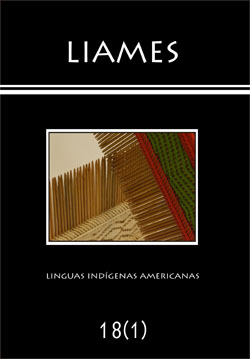Resumen
This article discusses the syntactic realization and discourse status of LOCATIVE expressions in motion constructions from the standpoint of the Preferred Argument Structure model (PAS; Du Bois 1987, Du Bois et al 2003). PAS posits two grammatical constraints on core arguments: (1) avoid more than one core lexical argument per clause, and (2) avoid lexical As. Our study examines whether LOCATIVE expressions, usually considered oblique or peripheral adjuncts, abide by the universal tendencies unveiled by PAS. The results show that, in terms of PAS, the discourse behavior of intransitive motion constructions is analogous to that of transitive constructions, and that the co-occurrence effects predicted by PAS to apply only to A and O arguments do affect S and LOCATIVE expressions as well. This suggests that PAS tendencies are sensitive to semantic argument status, independently of the arguments’ syntactic role and its morphological marking as direct vs. oblique. The data comes from three Uto-Aztecan languages (Yaqui, Guarijio and Nahuatl) and Spanish.Citas
Beavers, John; Levin, Beth.; Tham, Shiao Wei (2010). A morphosyntactic basis for variation in the encoding of motion events. Journal of Linguistics 46(3): 331-377. doi:10.1017/S0022226709990272
Beavers, John; Levin, Beth; Tham, Shiao Wei (2009). The typology of motion events revisited. http://www.stanford.edu/~bclevin/pubs.html
Beller, Richard; Beller, Patricia (1979). Huasteca Nahuatl. In Ronald W. Langacker (ed.). Studies in Uto-Aztecan Grammar Volume 2 Modern Aztec Grammatical Sketches, pp.199-306.Texas: Summer Institute of Linguistics & University of Texas at Arlington.
Belloro, Valeria A.; Guerrero, Lilián (2012). La interfaz gramática-discurso en las construcciones de movimiento en yaqui. Lingüística 27: 1-24. Accesible en: http://www.scielo.edu.uy/pdf/ling/v27n1/v27n1a09.pdf
Bentivoglio, Paola (1993). La estructura argumental preferida del español moderno. In María Vaquero; Amparo Morales (eds.). Homenaje a Humberto López Morales, pp. 107-120. Madrid: Arco Libros.
Du Bois, John W. (1987). The discourse basis of ergativity. Language 63(4): 805-855.
Du Bois, John W. (2003a). Discourse and grammar. In Michael Tomasello (ed.). The new psychology of language. Cognitive and functional approaches to language structure, pp. 47-87. New Jersey: Lawrence Erlbaum.
Du Bois, J. W. (2003b). Argument structure. Grammar in use. In John W. Du Bois; Lorraine E. Kumpf; William J. Ashby (eds.). Preferred argument structure. Grammar as architecture for function, pp. 11-60. Amsterdam: John Benjamins.
Du Bois, John W; Kumpf, Lorraine E.; Ashby, William J. (2003). Preferred argument structure. Grammar as architecture for function. Amsterdam: John Benjamins.
England, Nora; Martin, L. (2003). Issues in the comparative argument structure analysis in Mayan narratives. In John W. Du Bois; Lorraine E. Kumpf; William J. Ashby (eds.). Preferred argument structure. Grammar as architecture for function, pp. 131-158. Amsterdam: John Benjamins.
Felix Armendariz, Rolando (2005). A grammar of River Guarihío (Ph. dissertations thesis). Houston: Rice University. Available at: https://scholarship.rice.edu/handle/1911/18900
Guerrero, Lilián (2006). The structure and function of Yaqui complementation. Munich: LINCOM.
Guerrero, Lilián (2012). La naturaleza de las frases locativas en construcciones de movimiento en yaqui. LIAMES. Línguas Indígenas Americanas 12: 81-99. Available at: https://periodicos.sbu.unicamp.br/ojs/index.php/liames/article/view/1483
Guerrero, Lilián (2014). Movimiento y espacio en lenguas de América. México: UNAM.
Helasvuo, Marja-Liisa (2003). Argument splits in Finnish grammar and discourse. In John W. Du Bois; Lorraine E. Kumpf; William J. Ashby (eds.). Preferred Argument Structure. Grammar as architecture for function, pp. 247-272. Amsterdam: John Benjamins. doi: 10.1075/sidag.14.12hel
Jackendoff, Ray S. (1990). Semantic structures. Cambridge, MA: MIT Press.
Kumpf, Lorraine E. (2003). Genre and preferred argument structure: Sources of argument structure in classroom discourse, In John Du Bois; Lorraine E. Kumpf; William J. Ashby (eds.). Preferred argument structure. Grammar as architecture for function, pp. 109-130. Amsterdam: John Benjamins.
Launey, Michel (1992). Introducción a la lengua y a la literatura náhuatl. México: Universidad Nacional Autónoma de México.
Peregrina, M. (2005). Caracterización de la transitividad en la narrativa náhuatl de la Huasteca Veracruzana desde una propuesta tipológica (M.A thesis). Hermosillo: Universidad de Sonora. Available at:
http://www.maestriaenlinguistica.uson.mx/wp-content/uploads/2011/02/8Tmpl.pdf
Slobin, Dan I. (1996). Two ways to travel: Verbs of motion in English and Spanish. In Sandra Thompson; Masayoshi Shabatani (eds.). Grammatical constructions: their form and meaning, pp. 195-217. Oxford: Oxford University Press.
Slobin, Dan I. (2008). Relations between paths of motion and paths of vision: A crosslinguistic and developmental exploration. In Virginia C. Mueller Gathercole (ed.). Routes to language: Studies in honor of Melissa Bowerman, pp. 197-221. Mahwah, NJ: Lawrence Erlbaum Associates.
Talmy, Leonard (1985). Lexicalization patterns: semantic structure in lexical forms. In Timothy Shopen (ed.). Language typology and syntactic description, vol. 3: Grammatical Categories and the Lexicon, pp. 57-149. Cambridge: Cambridge University Press.
Talmy, Leonard (1991). Path to realization: a typology of event conflation. Papers of the 17th Annual Meeting of the Berkeley Linguistics Society, pp. 480-520. Berkeley: Berkeley Linguistics Society.
Talmy, Leonard (2000). Toward a cognitive semantics. Cambridge: MIT Press.
LIAMES: Lenguas Indígenas Americanas utiliza la licencia de Creative Commons (CC), preservando así la integridad de los artículos en ambiente de acceso abierto.


